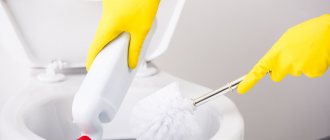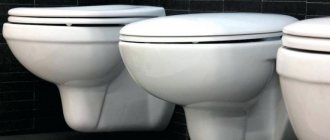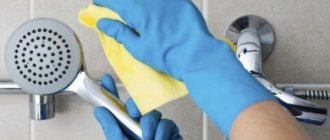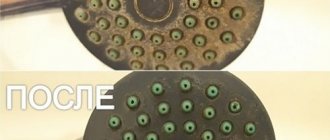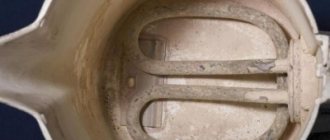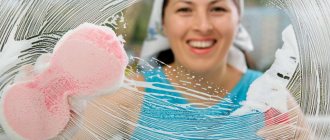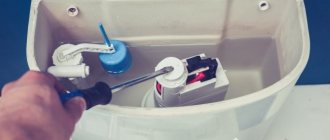After prolonged use of the toilet and improper cleaning and cleaning, deposits in the form of urinary stones appear on the walls of the toilet, rim and drain hole of the toilet. This also occurs when the tank is not drained completely or regularly, often in families with small children. As a result, mineral deposits form on the walls and bottom of the toilet.
We often have to deal with the fact that even with regular care of the plumbing, the surface of the toilet bowl darkens, rust spots and traces of limescale appear on it. How to clean the toilet from dirt yourself? How to remove urinary stone, plaque and rust? What cleaning solution or powder should I use to clean my toilet until it shines without damaging the surface? First, you need to understand how certain types of deposits are formed.
How to clean a child's potty from plaque
If you wash the pot thoroughly immediately after using it for its intended purpose, then no plaque will have time to form.
If it has formed, then Domestos cleans it up quite well. It is also good for disinfection. The pot should be disinfected periodically, so I am for Domestos. The main thing is to wash it off thoroughly afterwards, it still contains chemicals.
trembling doe
I found an interesting way to clean a child’s plastic potty from plaque. If you pour water into it that has just boiled in a kettle, then the high temperature will cause the plastic to begin to expand, and the plaque will bounce off the walls.
trembling doe
There is an excellent tool, quite inexpensive. Sold in almost all hardware stores. It's called Chistin. Turns urinary stone into jelly and is easily washed off with a stream of water. Eliminates the problem of scraping. Does not damage the surface, even plastic.
I asked myself this question and researched Google. What I tried: Domestos, Sanox, whiteness, duckling for cleaning toilets - the result was little. The following recipe helped:
lemon acid. Sprinkle the whole bag evenly over the stone at the bottom of the pot. boiling water. Pour boiling water to the point where the urinary stone deposit ends. leave for about a couple of hours. Then scrub the stone with a stiff brush (possibly with force). Be sure to clean the pot with gloves, because the acid is very concentrated and burns the skin on your hands.
It helped me. I hope this method will help you too. The recipe is also suitable for cleaning plastic cat litter.
Nastya Khokhlova
I poured just a little Titan detergent into the pot, let it sit for about five minutes, and then used a brush to clean off the deposits. Afterwards, rinsed thoroughly with warm running water. There is no residue left and no odors (urine or product). The product does not change color.
Galina Vasilna
If you not only rinse the pot, but also wipe it dry with a good cloth, it will shine and there will be no deposits. But if it’s already sunken, you can rub it with baking soda and then moisten it with vinegar. The plaque will soften, part of it will fly off on its own and rub the rest with a washcloth.
Rose of the World
You can use any product that is used to clean toilets. Only after it will you need to thoroughly rinse the pot to completely remove the product. The plaque will disappear. To prevent it from appearing again, wash the pot thoroughly.
How to clean a children's plastic potty from urinary stone deposits?
I found an interesting way to clean a child’s plastic potty from plaque. If you pour water into it that has just boiled in a kettle, then the high temperature will cause the plastic to begin to expand, and the plaque will bounce off the walls.
There is an excellent tool, quite inexpensive. Sold in almost all hardware stores. It's called Chistin. Turns urinary stone into jelly and is easily washed off with a stream of water. Eliminates the problem of scraping. Does not damage the surface, even plastic.
If you wash the pot thoroughly immediately after using it for its intended purpose, then no plaque will have time to form.
If it has formed, then Domestos cleans it up quite well. It is also good for disinfection. The pot should be disinfected periodically, so I am for Domestos. The main thing is to wash it off thoroughly afterwards, it still contains chemicals.
I asked myself this question and researched Google. What I tried: Domestos, Sanox, whiteness, duckling for cleaning toilets - the result was little. The following recipe helped:
- lemon acid. Sprinkle the whole bag evenly over the stone at the bottom of the pot.
- boiling water. Pour boiling water to the point where the urinary stone deposit ends.
- leave for about a couple of hours. Then scrub the stone with a stiff brush (possibly with force). Be sure to clean the pot with gloves, because the acid is very concentrated and burns the skin on your hands.
It helped me. I hope this method will help you too. The recipe is also suitable for cleaning plastic cat litter.
I poured just a little Titan detergent into the pot, let it sit for about five minutes, and then used a brush to clean off the deposits. Afterwards, rinsed thoroughly with warm running water. There is no residue left and no odors (urine or product). The product does not change color.
You can use the same product you use to clean the toilet. I sometimes add a small amount of product to the brush container and the product does not corrode the plastic. The main thing is to rinse it thoroughly so that the product does not remain and the child cannot come into contact with it.
Removing plaque with vinegar is a good option, but it takes a long time. You can speed up the process by using hot water, but then the smell will be much more intense.
You can try organic products, for example from Klar. But they cannot be called safe; the product is made on the basis of lactic acid.
But I haven’t come across any special products for children, as is the case with washing powders or fabric softeners.
The following product is suitable for cleaning: take a little vinegar essence, mix it with water and heat the solution to approximately 40 degrees, then add baking soda there. Pour this solution into the pot and leave overnight. In the morning, we clean off the deposits with a brush, a plastic scraper or a hard sponge.
You can also use Coca-Cola, citric acid and baking soda to clean a plastic pot from urinary stone.
You can use a toilet cleaner, for example Domestos, which does an excellent job of removing plaque.
Pour a little Domestos into the pot and leave it overnight, rinse well in the morning.
You can also use soda, sprinkle the soda well on the sponge and scrub thoroughly, after that you can wipe it with vinegar, then you need to wipe the pot dry.
If you not only rinse the pot, but also wipe it dry with a good cloth, it will shine and there will be no deposits. But if it’s already sunken, you can rub it with baking soda and then moisten it with vinegar. The plaque will soften, part of it will fly off on its own and rub the rest with a washcloth.
You can use any product that is used to clean toilets. Only after it will you need to thoroughly rinse the pot to completely remove the product. The plaque will disappear. To prevent it from appearing again, wash the pot thoroughly.
It is necessary to wash the pot immediately after use, and after each use, in this case no plaque will appear on its walls at all.
Or you can use liquid dishwashing detergent and warm water, pour water into the pot, pour in the detergent, mix and leave for a while.
Pour the water out of the pot and rinse it thoroughly under running water.
We had problems with the potty for a very long time. Well, the child doesn’t like him and that’s all. Until we bought a potty with a toy. From then on things went smoothly. My daughter happily sat on the potty and played at first. Subsequently, the toy was removed and the potty began to be used for its main purpose. The main thing for the child is to create a positive attitude towards the potty, but decide for yourself how.
Cleaning a toilet is not an easy task, especially if there is old dirt. Depending on how severe the contamination is, the following products are used. For example, you can try to remove urinary stones using ordinary acetic acid. Better, 70%. Pour a glass of vinegar into a container and heat it on the stove. After this, you can pour the vinegar into the toilet and add soda. The product should help if the dirt is not yet deeply ingrained. If the dirt is old, then you can try using oxalic acid. It is sold in powder and is called technical. It is usually dissolved in the toilet and left for about an hour. After this, use a brush to remove dirt. Of the store-bought products, I trust “comets” the most, although most special products do the job just as well.
Tools for cleaning toilet bowls from urinary stones
If you don't take care of your toilet properly, one day the dirt will have to be scrubbed off. It is important to know how to clean a toilet from urinary stones and which products are most effective. A urine stone forms gradually on the rim and outlet due to irregular rinsing of urine and poor cleaning; at first it looks like a plaque. If it is not removed and care is not taken in the future, the plaque will thicken and turn into urinary stone.
If you don't take care of your toilet properly, one day the dirt will have to be scrubbed off.
Where does the problem come from?
The appearance of urinary and limescale deposits is inherent in any plumbing product that is used frequently and regularly.
Both types of pollution do not form at one moment, but gradually, month after month. Unsightly deposits are the result of improper use of the toilet, in particular, untimely flushing, defects in the ceramic or porcelain surface and insufficient hygienic cleaning. The fact is that human urine has a specific mineral set, and if you do not train yourself to constantly drain it after yourself, then these very minerals form layers of urinary stones. Over time, they harden and are no longer easy to clean with a standard toilet brush.
A similar situation arises with lime deposits. But the speed and intensity of its formation depends not only on the above factors, but also on the quality composition of the water.
How to wash without harming
The deposits formed inside the toilet are brown in color, their appearance is unpleasant, creates a feeling of uncleanliness, so you really want to get rid of them. Before you clean the toilet from urinary stones, you need to know how to do it so as not to cause harm. You cannot pour boiling water into the toilet, as its surface and plastic sewer pipes cannot withstand temperatures above 85°C. When exposed to boiling water, the plastic may become deformed, and the toilet bowl may become covered with cracks and even burst. You cannot use metal brushes and sponges, as well as coarse hard abrasive powders, no matter how severe the contamination, as this will damage the glaze.
The deposits formed inside the toilet are brown, their appearance is unpleasant, creates a feeling of uncleanliness, so you really want to get rid of them
When using chemicals, special care should be taken: avoid contact with the skin, and when cleaning, do not tilt your head low over the device so as not to breathe in the fumes. The chemical should not get on the toilet lid fastenings, as it can corrode the parts and eventually they will break. Wash the toilet using thick rubber gloves with a brush, a stiff brush or a sponge with a rough layer. Narrow brushes are used to remove dirt from hard-to-reach places.
Before using this or that product, you must read the instructions and follow them. With proper care, the toilet looks decent even after 10 years of use.
Using a Steam Cleaner
This modern device is designed to clean various surfaces by dissolving and melting dirt under the influence of a powerful jet of steam. The device comes with attachments, including those specifically designed for the toilet. Using the rounded one, you can direct a stream of steam under the rim. The brush attachment is convenient for simultaneously softening and removing urinary stones. Additionally, the temperature of the steam speeds up chemical reactions, making the toilet cleaner more effective. Cleaning not just the toilet, but the entire bathroom with a steam cleaner is quick and easy. You can avoid using detergents at all when cleaning or use less of them. Steam penetrates everywhere, knocks out dirt and disinfects. After this, all surfaces should be wiped dry. A toilet that is cleaned with a steam cleaner never has any unpleasant odors.
Contamination inside the toilet appears systematically, so basic cleaning must be carried out constantly. It’s easier to do this every day for 5 minutes than to then kneel in front of it for half a day, rub and scrape, or go get a new one. It’s not difficult to train yourself and your family to keep the plumbing in your home clean and well-maintained.
Cleaning process
Whatever solution you choose to clean the toilet from urinary stones, first of all you need to drain the water seal. This can be done by putting water into an enema or plastic bottle with a tip. Collect it with a sponge and rag. After this, all contamination and the scope of work will appear in full. You may find that urinary stone in the toilet, in the corners of the drain hole, is as thick as a finger. If everything is not so bad as to clean the toilet from plaque, apply the detergent for an hour, then rub it with a brush and rinse it off.
Alkaline products (Belizna, Domestos) or acid-based products (Silit Beng toilet gel) dissolve urinary stones. For medium-intensity pollution, apply the selected product for 6-10 hours. To clean the rim, moisten paper napkins and place them on the stains.
All of the above products are also suitable for removing limescale, which is formed from the minerals contained in the drain water. The more often you flush, the greater the likelihood of accumulation. The sediment gradually eats into the surface of the plumbing, making it rough. To remove plaque in the toilet using home remedies, try the following remedy: apply 0.5 liters of Coca-Cola to problem areas, leave for 2-3 hours and remove the dirt with a brush.
You can remove stone from a toilet without removing the water from it. If the formations are not very dense, try using concentrated Antikalk powder. The product must be added to the drain hole (1-2 tablespoons), and after the reaction is completed (after about 20 minutes), clean it. If you have Antikalk in liquid form, you will need at least 500 ml.
To prevent the formation of plaque and stone, you can purchase special tablets for toilet tanks. Depending on the concentration of active ingredients and the number of rinses, 1 tablet removes signs of plaque within 2-8 weeks.
The selected product is applied to the stains, left for several hours, after which it is cleaned with a fiber sponge, which is harsh on the surface.
Additional recommendations
Having decided to clean the lid or rim of your toilet using industrial household chemicals, you need to pay attention to its quality composition. It may contain flavors or fragrances, but your attention should be focused on the presence of anionic surfactants, carbonate, sodium salts and silicate.
It would be ideal if the manufacturer used sulfuric or formic acid instead of this entire chemical set.
Both of these substances can destroy not only lime or urea, but also old rust.
Once you have dealt with the problem, try to prevent it from reoccurring. For this purpose, you need to clean the compact once a week with a brush, sponge and usual household chemicals.
Removing old dirt
An electrolyte is effective in removing urinary stones that have accumulated over the years. You should work with it carefully, wear gloves and goggles, and apply it carefully without splashing. It will quickly dissolve the thick layer of stone inside the toilet, but can damage the sewer line made of plastic pipes.
If the toilet has not been cleaned for a long time, oxalic acid powder will help remove deposits. It is applied to a moistened sponge and removes dirt. You can sprinkle acid on the stains and leave for an hour. After completion of work, its residues should be thoroughly washed off.
To clean the toilet of dense deposits, first of all, they must be softened. The selected product is applied to the stains, left for several hours, after which it is cleaned with a fiber sponge, which is harsh on the surface. Some are difficult to achieve and the procedure has to be repeated. Housewives often use the following folk remedies to clean stone from plumbing fixtures:
- 1 cup 9% vinegar mixed with 1 tbsp. l. soda;
- citric acid powder or dissolved in water.
Soak seedling pots in bleach solution
To disinfect ceramic and clay pots for growing seedlings, thoroughly wash them to remove soil and organic matter and soak them in a solution of one part household chlorine bleach to 9 parts water for at least 10 minutes. It is convenient to work in a bucket, as you will need less working solution. Then dip in dishwashing detergent and rinse. To remove mineral deposits and other debris from clay pots, use a wire brush. Scrape off any remaining mineral deposits with a knife.
Rinse the pots thoroughly and soak them in a bucket of clean water.
Dry well, group by size and place in neat piles in a clean, dry place, such as a greenhouse.


